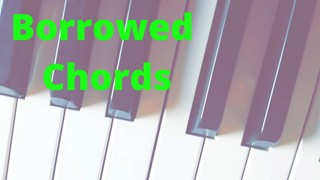Do you ever feel the desire to borrow chords from somewhere because you keep playing the same old harmony? I want to talk to you about borrowed chords. Every key of music has a set of chords that are the standard chords used. Even though you can voice them in many ways for variety, there are times when you want to think out of the box and make  things interesting.
things interesting.
Those standard chords are what we call diatonic harmony. Diatonic simply means within the key. In other words, the chords are made up of notes that are in the key that song or piece of music is in. This makes it easier to harmonize songs without having to guess which chords to use.
But it also can make your songs sound predictable and uninspiring. This is especially true if you only use diatonic harmony in your music.
A quick note on diatonic harmony in C Major: If you're familiar with the number system, you're aware that each tone in a key of music has a corresponding chord.
If you're familiar with the number system, you're aware that each tone in a key of music has a corresponding chord.
Diatonic harmony in C Major:






As I stated before, the diatonic chords are the most used in the key. But they're not the only chords available to you. You can borrow chords that aren't in the key.
So where do these borrowed chords come from? There are a lot of scales that have the same tonic (first note in the key) and you could borrow chords from any of these. But that's beyond the scope of this article.
I want to share with you the concept of borrowed chords from a parallel key. Parallel keys are in a parallel relationship. This means that they have the same tonic but a different key signature. One is a Major key and the other is a minor key.
What this means in the context of borrowed chords is that you can borrow from the minor key when you're playing in a Major key and vice versa.
So the key of C minor is the relative minor of C Major. The diatonic harmony in the key of C minor is opposite of C Major.
The diatonic harmony in the key of C minor is opposite of C Major.






Here's where borrowed chords come in. Let's say you're playing in the key of C Major. We'll take a simple I IV V chord progression.
I IV V chord progression


These are the primary chords in the key of C Major and they're all Major chords.
But you have the option of borrowing chords from the parallel minor key (C minor).
For example, you could borrow the iv chord from the parallel minor key.


or the v chord...



You could even borrow the i chord from the parallel minor key.


These are just primary chords that you can borrow from parallel minor keys. And I've only shared with you C Major and C minor. You have 11 other Major and minor keys so be sure you're aware of those as well.
You also have secondary chords in a Major key of music, most of which are minor keys. We'll take a look at those in the next article.
Until next time, Go Play!
Greg Lee
Latest posts by Greg Lee (see all)
- What is a minor/Major 7 Chord? - October 26, 2023
- 7 Chord Substitutions that Professionals Use - October 19, 2023
- 5 Simple Chord Tricks to Sound Amazing - October 5, 2023



